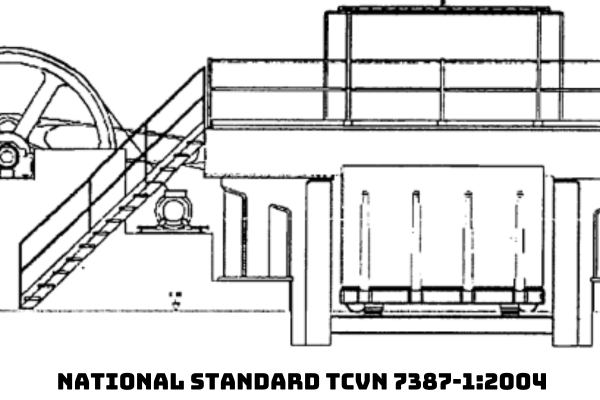Vietnam: What are the details of National Standard TCVN 7387-1:2004 on Safety of machinery - Permanent means of access to machinery?
What are the details of National Standard TCVN 7387-1:2004 on Safety of machinery - Permanent means of access to machinery in Vietnam?
National Standard TCVN 7387-1:2004 is fully equivalent to ISO 14122-1:2001
National Standard TCVN 7387-1:2004 compiled by Technical Committee of TCVN/SC 1 General mechanical issues, proposed by the Directorate of Standards, Metrology and Quality, and issued by the Ministry of Science and Technology.
National Standard TCVN 7387-1:2004 was converted in 2008 from Vietnam Standard with the same number to National Standard as prescribed in Clause 1, Article 69 of the Law on Standards and Technical Regulations 2006 and Point a, Clause 1, Article 6 of Decree 127/2007/ND-CP.
National Standard TCVN 7387-1:2004 specifies the general requirements for safe access to machinery as stated in EN 292-2, giving guidance on the selection of the permanent means of access to machinery when it is not possible to access to machinery directly from the ground or floor.
National Standard TCVN 7387-1:2004 applies to all types of machinery (static and mobile) requiring fixed means of access. This National Standard applies to means of access that are part of machinery.
National Standard TCVN 7387-1:2004 also applies to means of access to a part of a building (e.g. working floors, pedestrian paths, ladders) on which types of machinery are installed, the main function for this part of the building is to provide means of accessing types of machinery.
Note: National Standard TCVN 7387-1:2004 may also be used for means of access outside the scope of application of this National Standard. At that time, it is necessary to pay attention to the provisions of Vietnamese standards and other relevant regulations.
National Standard TCVN 7387-1:2004 also applies to means of access used separately for machinery, which are not permanently installed in machinery and can be removed or moved to the side for some machine intensities (for example, replacing tools in large presses).
National Standard TCVN 7387-1:2004 does not apply to lifts, lifting floors, or other equipment designed specifically for lifting people between two levels.

What are the requirements for selecting stepladders or ladders in Vietnam?
Pursuant to Section 5.3.2, Subsection 5.3, Section 5 of the National Standard TCVN 7387-1:2004, the requirements for selecting stepladders or ladders in Vietnam are:
- In the design of means of access to machinery, it is necessary to avoid the use of stepladders and ladders due to the high risk of falling, because it takes a lot of effort when using these approaching vehicles.
- If access facilities as stated in Section 5.3.1 Section 5 of National Standard TCVN 7387-1:2004 cannot be obtained, the choice of ladder chair or ladder may be considered. The final decision must be made on the basis of a risk assessment, including the ergonomic aspect.
If the level of risk is considered too high, the basic structure of the machinery approach must be changed to allow the use of a less risky machine access line.
- The following introduces some examples of possible cases where a ladder chair or ladder can be selected, these are just examples and the final selection must be made for each specific case on the basis of risk assessment. In most cases, more than one of the following conditions must be met when selecting a ladder or ladder chair.
+ Short vertical distance;
+ Access facilities are not used often.
Note: When evaluating the frequency of use, the entire "service life" of machinery must be considered. If means of access are used frequently, for example, during the assembly or installation of types of machinery or during the performance of main, periodic maintenance tasks, then ladder chairs or ladders are not a satisfactory solution.
+ Users are not allowed to bring large tools or other devices when using means of access;
+ Only one user is allowed to use means of access at the same time;
+ It is forbidden to use means of approach for the purpose of evacuating the injured;
+ The structure of machinery must not have stairs or other basic facilities.
Note: Examples are tower cranes and types of mobile machinery.
- For selection between stepladders or ladders, see subsection 5.5 Section 5 of National Standard TCVN 7387-1:2004
What are some examples of changes in machinery or systems for better accessibility?
Based on Appendix A of National Standard TCVN 7387-1:2004, there are examples of changes in machinery or systems for better accessibility as follows:
(1) Change the position of pillars, beams, pipes, cable chucks, platform floors, tanks, etc. so that stairs designed in accordance with this standard or other preferred means of access can be used.
(2) Change the design of approaches (e.g., layout) so that staircases designed in accordance with this or other preferred means of access can be used.
Example 1: Approach from the other side for rooms large enough for staircase installation is designed in accordance with this standard. Horizontal flooring can be added if deemed necessary.
Example 2: Change the design of the approach so that the staircase layout can be made (e.g., changing direction).
(3) Change machinery so that it is not necessary to access from the ground or floor.
Example 1: Arrange lubrication points near the ground by equipping hoses.
Example 2: Use a different method of lubrication, for example:
+ Lubricate regularly.
+ Lubricate the circulation with a pump.
Example 3: Engines and power transmission media are positioned so that service and service points are accessible from the ground.
Example 4: Machinery is installed at another location so that it can be accessible, for example, where there is a floor or pedestal convenient for access.
Example 5: Change the position of pipes and/or valves so that they can be operated from the ground or floor.
LawNet